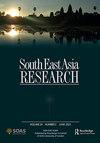Making Mindanao: place-making and people-making in the southern Philippines
IF 0.9
3区 社会学
0 ASIAN STUDIES
引用次数: 0
Abstract
When I was originally invited to give a keynote address for the two-day SOAS conference on Mindanao in July 2019 that formed the basis for this special volume, I offered a rather grandiose title for my talk as an attempt to link up to its theme of cartographies and identities: ‘Becoming Mindanao, becoming Mindanawon: narratives of place-making and people-making over the centuries’. With cartography pluralized, the conference theme embodied very aptly a fundamental reality of historical, political, anthropological and other types of academic research, i.e. that there can be multiple ways of representing and interpreting something, multiple ways of making it real, multiple ways of manifesting a place and its people. I had wanted to seize on this truth and use it as a jumping off point to talk about how we could nurture meaningful scholarship on Mindanao, and talk about the ways in which we construct and deconstruct both Mindanao and Mindanawons through our research. The wonderfully eclectic selection of papers that were presented – only a handful of which appear in this volume – provided a good cross-section of the quality, depth and diversity of scholarship possible for Mindanao, the southern Philippines more generally, and for other places like it. Places that, through the accident of modern national politics and history, have been relegated in academic research and scholarship to peripheral status at best, silence more commonly, in the face of national narratives, and total erasure at worst. This neglect of Mindanao is reinforced further by the cliquish tendencies of Philippine studies (as with any Area Studies endeavour), and its persistently ‘national’ optics that, to those of us who study ‘provincial’ places, peoples and topics, seems to bear down on our scholarship like an intellectual panopticon at times. In addition, academic research both in and on Mindanao – as represented in the annotated bibliography by the Mindanao Studies Consortium (2005) – has lagged relative to national scholarship, to the significant detriment of the field, as Patricio Abinales argues in ‘What sayeth the margins? A note on the state of Mindanao scholarship in Mindanao’ (this volume). In my own experience, scholarly voices speaking of or from Mindanao also tend to be explicitly provincialized, relegated to a lone ‘Mindanao’ panel at a Philippines conference regardless of the actual relatedness of their research topics. Thus the tremendous value of this conference, focused on this obscure(d) place, was in its deliberate centring of Mindanao not as a subset of Philippine studies nor removed entirely from it, but read autonomously in its own right. This approach has, by fortunate design, drawn scholars who棉兰老岛的制造:菲律宾南部的地方制造和人的制造
当我最初被邀请在2019年7月为期两天的棉兰老岛SOAS会议上发表主旨演讲时,我为我的演讲提供了一个相当浮夸的标题,试图与地图和身份的主题联系起来:“成为棉兰老,成为棉兰纳旺:几个世纪以来的地方和人的故事”。随着地图学的多元化,会议主题非常恰当地体现了历史、政治、人类学和其他类型学术研究的一个基本现实,即可以有多种方式来表现和解释某个事物,可以有多种方法使其真实化,可以有多种方式来表现一个地方及其人民。我曾想抓住这个事实,并将其作为一个起点,谈谈我们如何培养有意义的棉兰老岛学术,以及我们通过研究构建和解构棉兰老和棉兰老人的方式。所提交的论文非常不拘一格——本卷中只出现了少数几篇——为棉兰老岛、菲律宾南部以及其他类似地区的学术质量、深度和多样性提供了一个很好的横截面,在学术研究和学术界,充其量被降级为边缘地位,在国家叙事面前,更常见的是沉默,最坏的情况是彻底抹杀。菲律宾研究的派系倾向(与任何地区研究一样)以及其持续的“国家”视角进一步强化了对棉兰老岛的忽视,对于我们这些研究“省级”地方、民族和主题的人来说,这似乎有时像一个智识全景一样压在了我们的学术上。此外,正如Patricio Abinales在《边际是什么?关于棉兰老岛在棉兰老群岛的奖学金状况的说明(本卷)。根据我自己的经验,谈论或来自棉兰老岛的学术声音也往往被明确地本地化,在菲律宾会议上被归入一个单独的“棉兰老”小组,而不管他们的研究主题的实际相关性如何。因此,这次会议的巨大价值,集中在这个模糊的地方,在于它有意将棉兰老岛作为菲律宾研究的一个子集,也不是完全从中删除,而是自主阅读。幸运的是,这种方法吸引了那些
本文章由计算机程序翻译,如有差异,请以英文原文为准。
求助全文
约1分钟内获得全文
求助全文
来源期刊

South East Asia Research
ASIAN STUDIES-
CiteScore
1.90
自引率
0.00%
发文量
42
期刊介绍:
Published three times per year by IP Publishing on behalf of SOAS (increasing to quarterly in 2010), South East Asia Research includes papers on all aspects of South East Asia within the disciplines of archaeology, art history, economics, geography, history, language and literature, law, music, political science, social anthropology and religious studies. Papers are based on original research or field work.
 求助内容:
求助内容: 应助结果提醒方式:
应助结果提醒方式:


